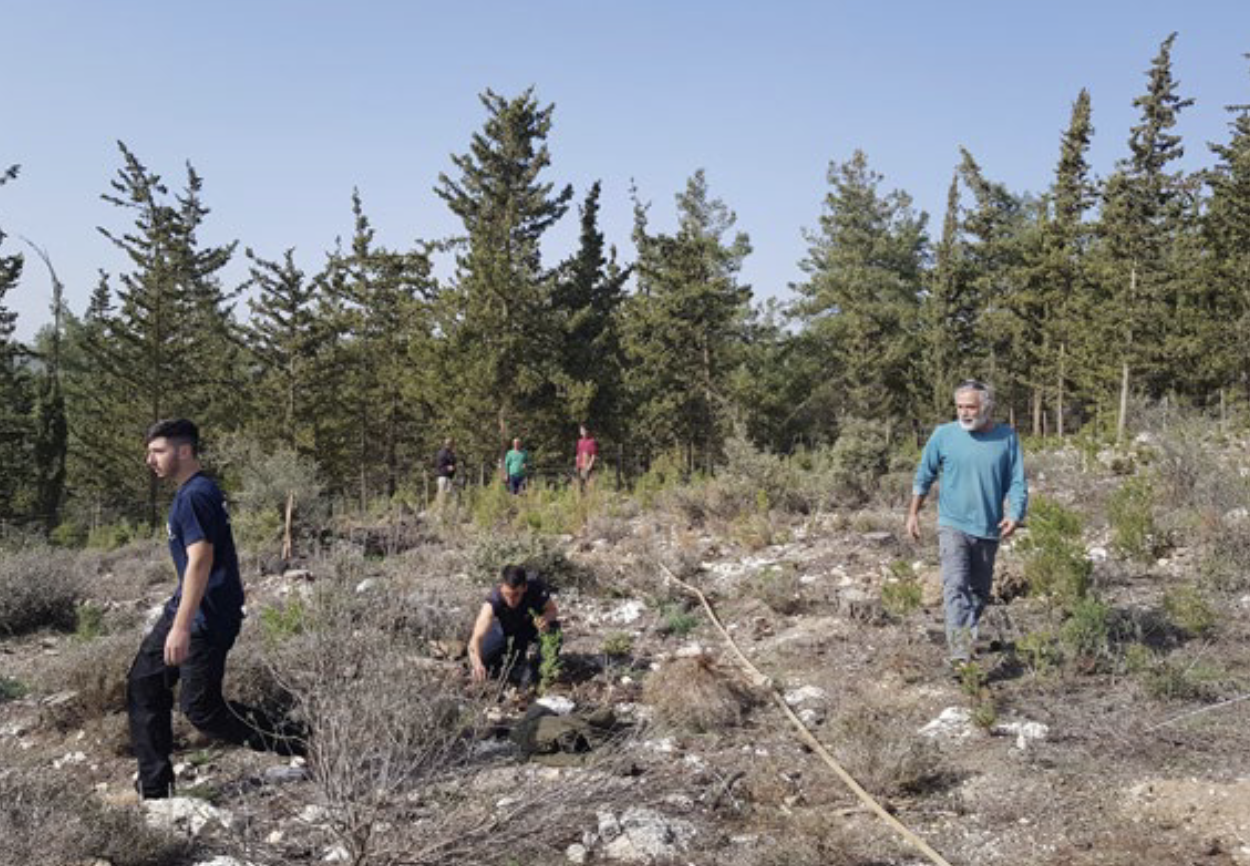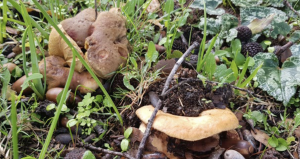KKL-JNF et Institut Migal (Israël) : accélérer la croissance des arbres grâce aux champignons mycorhiziens

[:fr]
Zavit. Des chercheurs du KKL-JNF et de l’Institut Migal (Galilée, Israël) ont trouvé un moyen naturel d’accélérer la croissance des pins par symbiose en utilisant des champignons comestibles durant les premières années de croissance. Tout au long de l’histoire de l’humanité, les champignons ont joué un rôle essentiel à travers le monde dans de nombreuses cultures anciennes. Les premières cultures grecques, romaines et chinoises connaissaient leur valeur nutritionnelle innée et les incorporaient dans leurs cuisines respectives. Aujourd’hui, on sait pourquoi les champignons étaient si appréciés. Non seulement ils sont dépourvus de cholestérol et faibles en calories, glucides, lipides et sodium, mais ils regorgent de nombreux nutriments importants associés à de nombreux avantages pour la santé. Le sélénium, le potassium, la riboflavine, la niacine, la vitamine D, diverses protéines, les fibres et les composés bioactifs contenus dans les champignons renforcent efficacement notre système immunitaire et permettent de traiter et prévenir de nombreuses maladies et affections sévères comme la maladie d’Alzheimer, la maladie de Parkinson, le cancer et l’hypertension.
Selon la nouvelle étude du KKL-JNF et de l’Institut Migal, les avantages des champignons comestibles ne se limitent pas uniquement aux humains : les arbres poussent plus vite lorsqu’ils sont contaminés par certains types de champignons comestibles. « Le KKL-JNF encourage le phénomène des forêts comestibles et souhaite créer des forêts avec des champignons comestibles mycorhiziens intéressants à récolter », explique le Dr Ofer Danay, directeur de la recherche champignons et truffes à l’institut Migal et co-auteur de la nouvelle étude. « Certaines espèces de pins, en particulier le pin parasol (Pinus pinea), ne survivent pas dans les sols calcaires, type de sol le plus courant en Israël », explique Ofer Danay. « Par conséquent, on tente à présent d’aider le pin parasol à faire face à ces difficultés en le contaminant avec des champignons mycorhiziens afin d’augmenter sa part dans les pinèdes, notamment parce qu’il est moins sensible aux ravageurs du pin et causer des problèmes de santé aux humains. Au-delà, augmenter la quantité de champignons dans le sol peut aussi aider à lutter contre la crise climatique ».
Weizmann : champignons mycorhiziens et CO2
« Selon les recherches du Dr Tamir Klein de l’Institut Weizmann, les champignons mycorhiziens réduisent la perte de carbone fixé dans le sol et réduisent la quantité de dioxyde de carbone émise dans l’atmosphère », explique Ofer Danay. Avec les spores de deux champignons comestibles populaires, Suillus collinitus et Lactarius deliciosus, les chercheurs ont infecté environ 120 pousses de trois espèces d’arbres différentes : le pin pignon (Pinus pinea), le pin de Calabre (Pinus brutia) et le pin de Jérusalem, également communément appelé comme le pin d’Alep (Pinus halepensis). Ils ont examiné comment l’infection fongique affecte les arbres au cours des deux premières années de leur vie avant qu’ils ne soient transférés dans un champ pour la plantation.
«Dès le stade de la pépinière, nous avons constaté que les arbres infectés par des champignons mycorhiziens se développaient mieux que les arbres du groupe témoin, qui n’étaient pas infectés par le champignon», explique Ofer Danay. L’étude a montré que les jeunes arbres infectés par trois espèces de pin échantillonnées étaient plus grands et que le diamètre de leur tronc était plus large. L’effet le plus important a été observé chez les espèces de pin de Jérusalem, qui étaient 180 % plus grosses que le groupe témoin. Cela a été observé ensuite chez le pin de Calabre, qui a montré une amélioration de 160 % en hauteur et en diamètre, puis chez le pin pignon, qui a présenté une augmentation de croissance de 124 %. Une croissance stimulée à ce degré est de bon augure pour les efforts de reboisement et de boisement.
Un lien de réciprocité
Pourquoi les arbres parasités par des champignons poussent-ils mieux ? La réponse réside dans le principe de la symbiose, ou de relation mutuellement bénéfique entre deux organismes. Dans ce cas, le champignon, qui enveloppe étroitement les racines de l’arbre, aide à fournir de l’eau et des nutriments essentiels comme le phosphore, le fer et le magnésium du sol pour le développement précoce de l’arbre. En retour, le champignon peut absorber les nutriments et les sucres dont il a besoin pour construire son organisme, que l’arbre produit par photosynthèse.
En raison de la présence de diverses espèces de champignons dans les sols, les racines des arbres s’entremêlent régulièrement et naturellement avec des champignons mycorhiziens. Grâce à l’utilisation de méthodes moléculaires, le Dr Danay pense qu’il est intéressant d’identifier les champignons mycorhiziens présents dans le sol afin de mieux choisir les espèces d’arbres qui peuvent le mieux les héberger pour assurer un développement et une survie rapides des arbres forestiers. « Cela permettra également de conserver les champignons, dont certains peuvent être utilisés pour l’alimentation et dont certains sont même en danger d’extinction ».
Malgré le risque que les arbres finissent par être infectés par le champignon «naturellement», il vaut mieux infecter les pousses pendant qu’elles sont dans la pépinière. « Nous prévoyons que les arbres infectés atteindront une taille qui leur permettra de démarrer et de produire des corps multiplicatifs des champignons mycorhiziens comestibles plus tôt que la situation actuelle», explique-t-il.
Au-delà du plaisir de l’expérience de recherche de nourriture et des multiples profils de saveurs de nombreux champignons comestibles, une identification erronée peut avoir des conséquences graves et potentiellement mortelles. « Chaque année, des cas d’empoisonnement sont signalés en raison d’une identification et d’une collecte incorrectes de champignons, pouvant même entraîner la mort », explique Ofer Danay. Il souligne l’importance de la prudence et de la rapidité lors de la collecte. « Celui qui cueille des champignons doit connaître parfaitement le champignon qu’il cueille et s’assurer de son identification. Il n’y a pas de règles empiriques sur le sujet, donc en cas de doute, évitez complètement de cueillir et de manger le champignon. Un autre point important est la nécessité d’éviter de trop récolter les champignons car cela peut nuire à leur capacité de récupération et de reproduction. « Ils doivent être récoltés de façon raisonnable – en petites quantités – afin que les champignons puissent continuer à se développer et à se répandre », explique Ofer Danay.
« Je reçois parfois des photos de personnes revenant de la cueillette avec des seaux pleins de champignons et laissant derrière elles un sol nu. C’est très problématique. » La préservation des champignons comestibles mycorhiziens qui poussent dans les forêts est particulièrement importante aujourd’hui en raison de la situation précaire de notre climat. « Ces dernières années, il y a eu une diminution de l’abondance et de la diversité de ces espèces de champignons dans la nature en raison de la surexploitation et de la crise climatique », explique Ofer Danay. « Il est important de préserver la biodiversité du champignon au profit de la santé de la forêt et pour la nôtre», conclut-il.
Publication dans yaar magazine
Auteur : Racheli Wacks pour l’agence Zavit
Traduction/adaptation Esther Amar pour Israël Science Info
[:en]
Israeli researchers have found a natural and symbiotic way to expedite the growth of pine trees by involving edible fungi mushrooms in their early years of growth. Throughout human history, mushrooms have played an integral role in many early cultures around the world. Early Greek, Roman, and Chinese cultures all recognized their innate nutritional value and incorporated them into their own respective cuisines. Through our modern understanding of science today, we specifically know the reason why mushrooms were so revered.
Beyond the fact that they are absent of cholesterol and low in calories, carbohydrates, fat, and sodium, they are packed with many important nutrients that have been linked to providing many important health benefits. Selenium, potassium, riboflavin, niacin, vitamin D, various proteins, fiber, and the bioactive compounds within mushrooms effectively work to boost our immune systems and are used to help treat and prevent many infamous diseases and ailments like Alzheimer’s, Parkinson’s, cancer, and hypertension.
The benefits of edible mushrooms, however, are not solely limited to humans according to a new Israeli study, which found that trees grew faster when they were infected with certain kinds of edible mushrooms.
A Good Infection
The new study was conducted in collaboration with researchers from the JNF and MIGAL – the Galilee Research Institute. “The JNF is trying very hard to encourage the phenomenon of edible forests and wants to create forests with mycorrhizal edible mushrooms that are interesting to collect,” says Dr. Ofer Danay, director of mushrooms and truffle research at MIGAL and co-author of the new study.
“Certain species of pines, especially stone pine (Pinus pinea), do not survive in calcareous soils, which are the most common type of soil in Israel,” says Danay. “Therefore, attempts are now being made to ‘help’ the stone pine cope with these difficulties by infecting it with mycorrhizal fungi as a means of increasing its share in pine groves, mainly because it is less susceptible to pine pests whose larva harms trees and potentially cause medical problems for humans.”
Beyond that, increasing the amount of fungus in the soil may help also help in the fight against the climate crisis. “According to research by Dr. Tamir Klein of the Weizmann Institute, mycorrhizal fungi reduce the loss of carbon fixed in the soil and reduces the amount of carbon dioxide emitted into the atmosphere,” explains Danay.
Beyond the pleasures of the foraging experience and the multiple flavor profiles many edible fungi mushrooms have, misidentifying one can have serious and potentially fatal consequences.
“Every year there are reports of poisoning due to incorrect identification and collection of fungi, which can even cause death,” says Danay. He emphasizes the importance of caution and diligence when collecting. “Whoever collects mushrooms should be completely familiar with the mushroom he or she is picking and be sure of its identification. There are no rules of thumb on the subject, so if there is any doubt, you should avoid picking and eating the mushroom altogether.”
Another important point is the need to avoid over-collecting mushrooms because this can impair their ability to recover and reproduce. “They need to be harvested in proportion—in small amounts—so that the fungi can continue to grow and spread themselves,” says Danay. “I sometimes get photos of people coming back from collecting with buckets full of mushrooms and leaving behind a bare ground. It’s a wrong, and it’s a problematic situation.”
Preserving the mycorrhizal edible mushrooms that grow in forests is especially important today because of the precarious situation we have placed our climate. “In recent years, there has been a decrease in the abundance and diversity of these fungi species in nature due to because of over-collection and the climate crisis,” says Danay. “It’s important to preserve the biodiversity of the fungus for the benefit of the forest’s health as well as our own,” he concludes.
 With the spores of two popular edible fungi, Suillus collinitus and Lactarius deliciosus, the researchers infected about 120 sprouts from three different species of trees: stone pine (Pinus pinea), Calabrian Pine (Pinus brutia), and Jerusalem Pine—also commonly referred to as Aleppo Pine (Pinus halepensis). They examined how fungal infection affects the trees during the first two years of their lives before they are transferred to a field for planting.
With the spores of two popular edible fungi, Suillus collinitus and Lactarius deliciosus, the researchers infected about 120 sprouts from three different species of trees: stone pine (Pinus pinea), Calabrian Pine (Pinus brutia), and Jerusalem Pine—also commonly referred to as Aleppo Pine (Pinus halepensis). They examined how fungal infection affects the trees during the first two years of their lives before they are transferred to a field for planting.
“As early as the nursery stage, we found that the trees infected with mycorrhizal fungi developed better than the trees from the control group, which were not infected with the fungus,” says Danay. The results of the study showed the infected young trees of the three sampled pine species were taller and their stem (trunk) diameters were wider. The greatest effect was seen in the Jerusalem pine species, which were 180% larger than the control group. This was followed by Calabrian Pine, which showed a 160% improvement in height and diameter, and then stone pine, which exhibited a 124% growth increase. Stimulated growth to this degree bodes well for reforestation and afforestation efforts.
A Reciprocal Relationship
So, why do fungus-infected trees grow better? The answer lies in the workings of symbiosis, or the mutual beneficial relationship between two organisms. In this case, the fungus, which densely envelops the tree’s roots, helps deliver water and essential nutrients like phosphorus, iron, and magnesium from the soil for the tree’s early development. In return, the fungus can absorb the nutrients and sugars it needs to build up its body, which the tree produces through photosynthesis.
Due to various fungi species’ presence in soil environments, tree roots become regularly and naturally entangled with mycorrhizal fungi. Through the use of molecular methods, Danay believes it’s worthwhile to identify which mycorrhizal fungi exist in the soil so as to better choose the species of trees that can best “host” them to ensure rapid development and survival of the forest trees. “This will also make it possible to preserve the mushrooms, some of which can be used for food and some of which are even in danger of extinction.”
It should be noted that despite the chance that trees may eventually become infected with the fungus “naturally,” there is a benefit in infecting the sprouts while they are in the nursery. “We anticipate that infected trees will reach a size that will allow them to start and yield multiplicative bodies of the edible mycorrhizal fungi earlier than the current situation,” he says.
Don’t Take Too Many
Beyond the pleasures of the foraging experience and the multiple flavor profiles many edible fungi mushrooms have, misidentifying one can have serious and potentially fatal consequences.
“Every year there are reports of poisoning due to incorrect identification and collection of fungi, which can even cause death,” says Danay. He emphasizes the importance of caution and diligence when collecting. “Whoever collects mushrooms should be completely familiar with the mushroom he or she is picking and be sure of its identification. There are no rules of thumb on the subject, so if there is any doubt, you should avoid picking and eating the mushroom altogether.”
Another important point is the need to avoid over-collecting mushrooms because this can impair their ability to recover and reproduce. “They need to be harvested in proportion—in small amounts—so that the fungi can continue to grow and spread themselves,” says Danay. “I sometimes get photos of people coming back from collecting with buckets full of mushrooms and leaving behind a bare ground. It’s a wrong, and it’s a problematic situation.”
Preserving the mycorrhizal edible mushrooms that grow in forests is especially important today because of the precarious situation we have placed our climate. “In recent years, there has been a decrease in the abundance and diversity of these fungi species in nature due to because of over-collection and the climate crisis,” says Danay. “It’s important to preserve the biodiversity of the fungus for the benefit of the forest’s health as well as our own,” he concludes.
Publication dans yaar magazine
Racheli Wacks for Zavit
[:]







